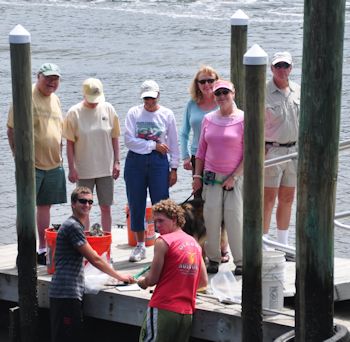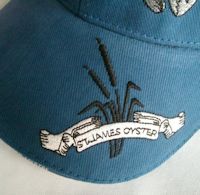ST. JAMES – They’re called The Royal Order of the Honorary St. James Oyster, and while there are no secret handshakes or arcane rituals involved they do wear baseball caps with the order’s logo, and most recently for a second version, the life cycle of the oyster stenciled on to them. There are tote bags, too.
Mostly, though, the volunteers who make up the group in Brunswick County tote bags full of oyster shells to build reefs and perform assorted other environmental good deeds.
Supporter Spotlight
They’ve done it so well that the group’s founder, J. Taylor Ryan, and its member who help researchers monitor baby oysters were among the 16 individuals, groups and agencies that received a 2012 N.C. Coastal Federation Pelican Award.
 Members of the St. James Citizen Volunteers work with UNCW researchers to monitor baby oysters. Photo courtesy of J. Taylor Ryan |
“These awards are our way of recognizing extraordinary commitment to protecting and preserving our coast,” said Todd Miller, the federation’s founder and executive director. “We should never underestimate the power that many people can bring to the effort of assuring that our coast remains a healthy and vibrant place. We can’t thank them enough.”
The “power of many people” was in particular evidence from the very start with The Royal Order of the Honorary St. James Oyster. About seven years ago, Ryan, a resident of St. James Plantation, attended a federation seminar and learned that an oyster could filter between 30 to 50 gallons of water a day. From other seminars he attended Ryan knew that such filtering can help clean pollutants in stormwater runoff. He immediately set out to create a pair of oyster reefs in the Intracoastal Waterway adjoining St. James Plantation community, a gated community near Southport that formally incorporated in 1999.
Ryan enlisted the aid of the federation’s Ted Wilgis; Sabrina Varnam, the oyster shell recycling coordinator for the state Division of Marine Fisheries; Troy Alphin, a researcher at the University of North Carolina-Wilmington; and Shelley Lesher, the mayor of St. James. After a year or two of organizing and coordinating, it was time to recruit volunteers to bag oyster shells, which would be used to build the reef, and get them in the water.
“When you advertise for one of these things, you’ll normally get 10 or so volunteers, and if you’re lucky, sometimes as many as 30 or 40,” said Alphin.
Supporter Spotlight
More than 90 people showed up.
“I was expecting several weekends of work,” said Alphin, “They filled between 1,500 and 1,700 bags, and it was done in about four hours.
“J. Taylor Ryan was very instrumental at getting everybody together at one time,” Alphin added. “He’s got a lot of energy and is very good at that.”
Varnam had just been hired by the fisheries division to head its recently-funded oyster shell recycling program. She had barely sat down at her new desk when she got the call from Ryan.
“It was a dream when he called,” she said. “It was so wonderful to find people in a community who wanted to get involved. Anytime I talk to groups, I always use the St. James group as an example.”
 The order members wear their hats with pride. Photo courtesy o J. Taylor Ryan. |
In time, Ryan organized his volunteers into the Royal Order of the Honorary St. James Oyster — Josann Campanello, the town’s administrator, came up with the name. Within the group are the St. James Citizen Scientist Volunteers, which shared this year’s Pelican Award with Ryan. They basically help UNCW researchers gather data to monitor baby oysters, or spat. While scientists evaluate the information, said Alphin, ordinary people “can read a thermometer, and collect the data for us.”
The volunteer group has become important to the residents of St. James Plantation. From Ryan’s awareness of what one oyster can do came a volunteer army that now boasts a distribution list of nearly 500 residents, with whom Ryan is quick to share credit.
“Of the many fine characteristics inherent to the people of this community,” said Ryan, “their spirit of volunteerism is unbelievable.”
One might say the same of Ryan himself. Though born in Morganton in the foothills of the Blue Ridge, he grew up in New York, first in the city and then in a small town up the Hudson River. He was a Boy Scout senior patrol leader and a member of his high school track team. He returned to North Carolina to get a degree in business administration from Wake Forest University. After a hitch in the Army’s Signal Corps, Ryan joined IBM in 1965 and stayed for almost 30 years. He moved to St. James Plantation in 2001.
“I just felt that I could have a far better lifestyle on the North Carolina coast than I could in New Jersey,” he said. “The plan was to come down here, look over a few retirement communities and spend some time thinking about it.
“I don’t spend money easily,” he added, “but I surprised myself… What a great decision that turned out to be.”
Drawing on his father’s post-retirement work teaching an outdoor education program in New Jersey and his own work as a Boy Scout camp counselor, it didn’t take long for Ryan to hook up with his community’s stormwater committee and begin attending federation seminars. He went on to join fishing clubs and boating clubs and has recently become a member of a turtle watch group on Caswell Beach.
After building those first two oyster reefs about six years ago, the group has added other reefs in the waterway that are UNCW research sanctuaries.
“I’ve been blessed with a very fortunate life,” Ryan said of his environmental activism, “and I wanted to give back to the community.”







